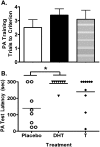Testosterone and dihydrotestosterone differentially improve cognition in aged female mice
- PMID: 19633137
- PMCID: PMC2726011
- DOI: 10.1101/lm.1428209
Testosterone and dihydrotestosterone differentially improve cognition in aged female mice
Abstract
Compared with age-matched male mice, female mice experience a more severe age-related cognitive decline (ACD). Since androgens are less abundant in aged female mice compared with aged male mice, androgen supplementation may enhance cognition in aged female mice. To test this, we assessed behavioral performance on a variety of tasks in 22- to 24-mo-old gonadally intact female mice treated for 6 wk with silastic capsules containing either testosterone (T) or dihydrotestosterone (DHT) or empty capsules (placebo). Compared with placebo-treated mice, spatial memory retention in the water maze was enhanced by testosterone treatment, but not DHT treatment. In contrast, DHT treatment improved passive avoidance (PA) retention, while T treatment only did so marginally. These data support that androgen supplementation in old female mice improves cognitive performance differentially depending upon the type of hormone treatment and cognitive task.
Figures






References
-
- Benice TS, Rizk A, Kohama S, Pfankuch T, Raber J. Sex-differences in age-related cognitive decline in C57BL/6J mice associated with increased brain microtubule-associated protein 2 and synaptophysin immunoreactivity. Neuroscience. 2006;137:413–423. - PubMed
-
- Bimonte-Nelson HA, Singleton RS, Nelson ME, Eckman CB, Barber J, Scott TY, Granholm AC. Testosterone, but not nonaromatizable dihydrotestosterone, improves working memory and alters nerve growth factor levels in aged male rats. Exp Neurol. 2003;181:301–312. - PubMed
-
- Clement Y, Calatayud F, Belzung C. Genetic basis of anxiety-like behaviour: A critical review. Brain Res Bull. 2002;57:57–71. - PubMed
-
- Cooke BM. Steroid-dependent plasticity in the medial amygdala. Neuroscience. 2006;138:997–1005. - PubMed
Publication types
MeSH terms
Substances
Grants and funding
LinkOut - more resources
Full Text Sources
